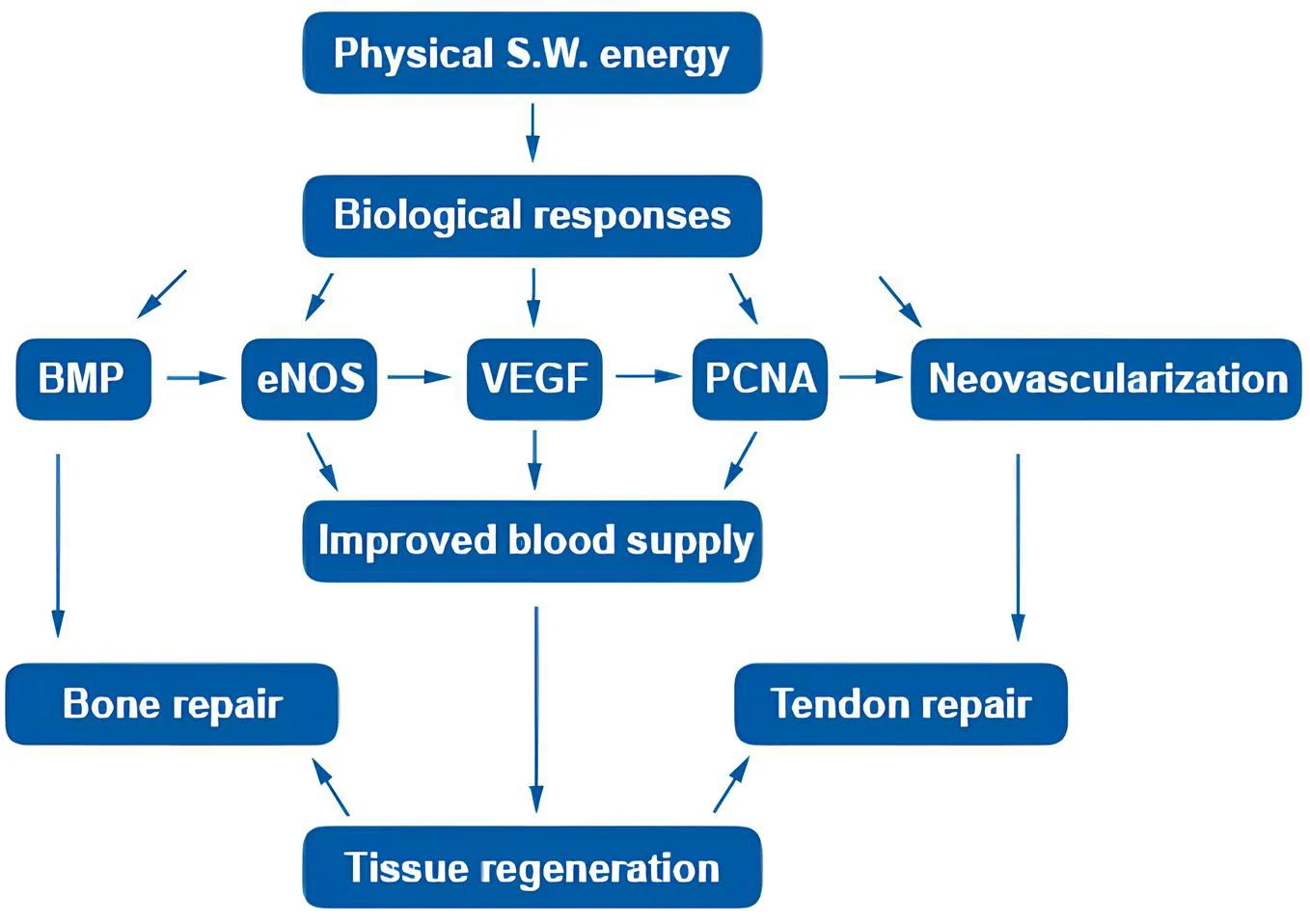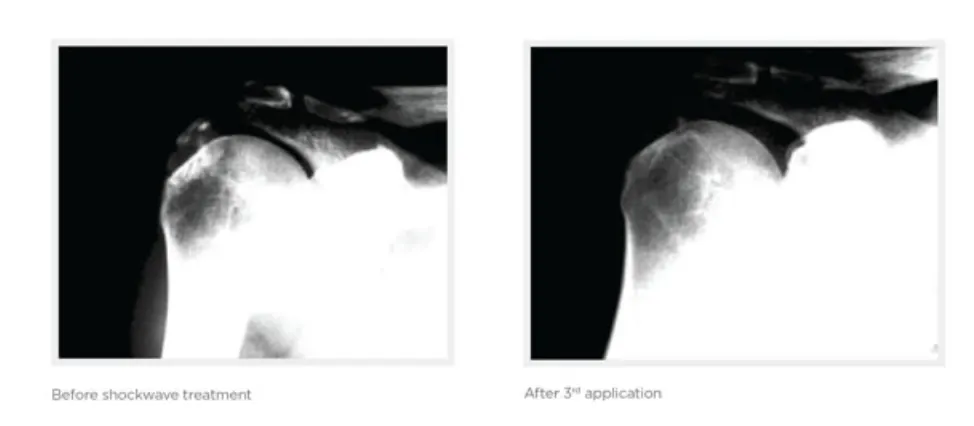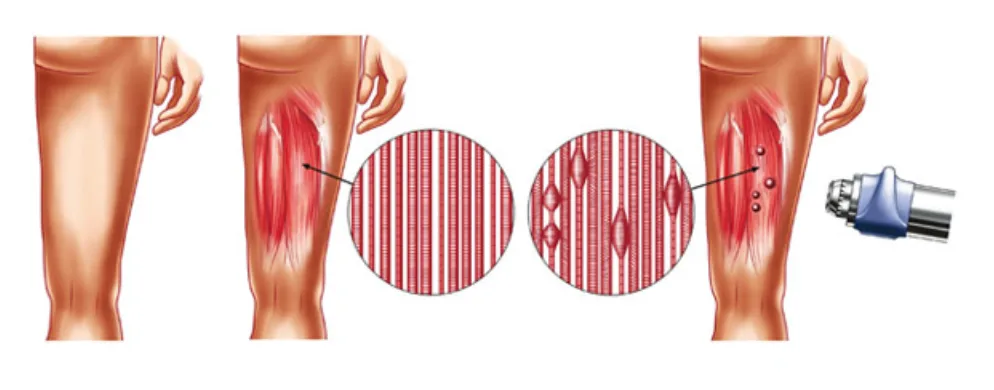Shockwave Therapy Machine FAQ: Experts Answer Your Common Questions
Simple Distinction
Shock wave therapy is a non-invasive physical therapy method that uses high-energy shock waves, either externally focused or through direct contact, to target diseased tissues such as muscles, tendons, ligaments, and bones. It can stimulate tissue repair, promote blood circulation, reduce inflammation, loosen adhesions, and inhibit the transmission of pain signals, thereby treating diseases and relieving pain.
Common shock wave therapy devices include pneumatic ballistic shock wave therapy devices, electromagnetic shock wave therapy devices, and piezoelectric shock wave therapy devices. Pneumatic ballistic shock wave therapy devices use compressed air to propel a projectile, which impacts a treatment probe to generate shock waves. Electromagnetic shock wave therapy devices use electromagnetic coils to generate a magnetic field, causing a metal diaphragm to vibrate and produce shock waves. Piezoelectric shock wave therapy devices rely on the deformation of piezoelectric crystals under the influence of an electric field to generate shock waves.
- Differences in Principle: Pneumatic shock waves use compressed air to propel a metal bullet, causing it to impact the treatment head and generate shock waves. Electromagnetic shock waves utilize the principle of electromagnetic induction. When current passes through a coil, it generates a magnetic field, which acts on a metal diaphragm, causing it to vibrate and generate shock waves.
- Energy Characteristics: Pneumatic shock waves have relatively concentrated energy, a higher peak energy, and a shallower penetration depth. Electromagnetic shock waves have a more even energy distribution and a deeper penetration depth, reaching deeper tissue layers.
- Treatment Experience: Due to the concentrated energy of pneumatic shock waves, patients may experience more noticeable pain during treatment. Electromagnetic shock waves are generally more tolerant of pain.
Different shockwave device models may differ in functionality, application scope, and ease of use. For example, some shockwave devices may feature more precise energy control technology and higher frequencies, enabling more accurate adjustment of shockwave energy output and depth of impact, potentially resulting in better treatment outcomes. These devices are particularly suitable for complex conditions requiring high precision. Portable devices, such as the V100, may offer advantages in size and weight, making them easier to carry and use in various locations, making them suitable for mobile treatments or primary care settings.
Usage Issues
You can contact us immediately by email and we will answer any questions. You can also refer to the device’s instruction manual and follow the steps to learn and practice. If you have any questions during the learning process, please feel free to contact our professional staff.
- Connecting the device: Ensure the power cord and related accessories are properly connected and the device is in standby mode.
- Selecting the mode and parameters: Based on the patient’s condition and treatment area, select the appropriate treatment mode and precisely adjust parameters such as treatment time and energy. For example, for first-time treatment or patients with high pain sensitivity, it is recommended to start with a low energy setting and gradually increase the energy level based on tolerance.
- Installing the treatment head: Select the appropriate treatment head based on the treatment area and securely attach it to the device.
- Locate the treatment area: Identify the specific area to be treated.
- Starting Treatment: Once everything is ready, press the start button to begin emitting shock waves.
- Ending Treatment: When treatment is complete, turn off the device and remove the treatment tip for safekeeping.
- Local skin reactions: Some patients may experience redness, swelling, itching, or a rash after treatment, which generally resolves on its own within a few hours to a few days.
- Increased pain: In rare cases, pain may temporarily increase during the initial treatment, but it usually subsides gradually. If pain persists or worsens significantly, notify your doctor immediately.
- Bruising: The shockwaves may rupture small blood vessels, leading to bruising. However, this usually resolves on its own over time.
Most side effects are temporary and resolve or disappear within 1-2 days of treatment. Therefore, there’s no need to be afraid of shock wave therapy. Numerous reports indicate that shock wave therapy is a very safe and effective treatment for chronic soft tissue inflammation, delayed fracture healing, and pain.
The frequency of treatment depends on the specific condition, individual patient characteristics, and the area being treated. Generally speaking, for acute injuries, such as mild muscle strains, treatments may be performed every two to three days. For chronic conditions, such as plantar fasciitis and frozen shoulder, treatments are usually performed once or twice a week. A complete course of treatment generally requires three to five treatments, but the specific duration and interval should be assessed and determined based on individual needs.
- Improper parameter settings: Excessive energy, excessive number of shocks per session, or inaccurate placement can overstimulate inflamed tissue and even damage healthy tissue. Before the next treatment, it is recommended to lower the energy level, start with a lower setting, and test gradually, shortening the duration of the shocks.
- Acute Lesion: If the treatment area is experiencing acute swelling, heat, and pain, the shock waves may exacerbate the inflammatory response. At this stage, acute inflammation should be controlled with medication or ice packs. Shockwave therapy can then be continued after the condition stabilizes.
- Individual Pain Sensitivity Differences: Some people are more sensitive to shockwave energy, especially focused shockwaves, or when the treatment area is densely nerved, such as the soles of the feet or elbows. Patients can proceed with treatment in stages based on their tolerance.
- Issues with Coupling Gel Use: Insufficient coupling gel can cause energy to reflect off the skin’s surface, causing severe stinging. During treatment, ensure that the coupling gel is applied adequately and evenly, and that the probe is firmly in contact with the skin. If unbearable pain occurs during treatment, the procedure can be paused and the treatment plan adjusted.
The duration of shockwave therapy’s effects varies depending on individual differences, the severity of the condition, the number of treatments, and follow-up care. Generally speaking, for some acute soft tissue injuries, such as mild muscle strains and tendinitis, pain and swelling can be significantly relieved within a few weeks after standard treatment, and the effects are relatively long-lasting. However, chronic conditions, such as long-term plantar fasciitis and severe frozen shoulder, may require multiple treatments, and the onset and maintenance of treatment effects can be relatively slow and complex. Some patients experience symptom improvement for months or even longer after completing a course of treatment, but others may experience recurring symptoms after a period of time due to factors such as daily habits and work schedules. Overall, proactive treatment can help prolong the duration of treatment effects.
- Skin Care: Minor skin reactions such as redness or swelling after treatment generally do not require special treatment. Keep the treated area clean and avoid scratching or rubbing to prevent skin damage and infection. If redness or swelling is severe or blisters develop, seek medical attention immediately.
- Rest and Activity: After treatment, it is recommended to rest adequately, avoid strenuous exercise and overexertion, and allow your body ample time to recover. However, prolonged bed rest is not necessary; moderate light activity can promote blood circulation and aid recovery. However, be careful to avoid excessive pressure or extensive movement on the treated area, as this may affect the treatment’s effectiveness.
- Observe Symptom Changes: Closely monitor changes in the treated area, such as pain and swelling, to see if they subside. If symptoms persist or worsen, or if fever or local numbness develop, seek a follow-up consultation promptly to investigate the cause and adjust the treatment plan.
- Diet: Maintain a balanced diet and increase your intake of foods rich in protein, vitamins, and other nutrients, such as lean meats, fish, and fresh fruits and vegetables, to aid in the repair and recovery of body tissues. However, there are generally no specific dietary restrictions.
-
Cleaning: Wipe the device housing regularly with a damp cloth. Soapy water or a neutral detergent can be used for auxiliary cleaning. Always disconnect the power cord before cleaning to prevent liquids from entering the device or piping, which could damage the device.
-
Accessory Inspection: Before and after each use, carefully inspect the treatment head, connecting cables, and other accessories for damage or wear. If any problems are found, replace them promptly to ensure proper operation.
-
Storage Environment: The device should be stored in a dry, well-ventilated environment with appropriate temperature and humidity to prevent environmental factors from shortening its lifespan.
The function and principle of shockwave therapy machine
Shockwave therapy is widely used in the treatment of musculoskeletal disorders, including chronic soft tissue injuries such as plantar fasciitis, Achilles tendinitis, frozen shoulder, tennis elbow, tenosynovitis, and patellar tendinitis. It can also promote callus formation in delayed or non-union fractures, aiding fracture recovery. Furthermore, it can provide pain relief and improve joint function in conditions such as osteoarthritis and early-stage femoral head necrosis.
Shockwave therapy isn’t suitable for everyone. Certain contraindications apply, including pregnancy, severe coagulation disorders (such as hemophilia), skin ulcers or infections, severe cardiopulmonary disease, pacemakers, bone tumors, and thrombosis. Furthermore, it’s not recommended for people who are highly sensitive to shockwaves and may experience severe discomfort.
Shockwave therapy can effectively relieve pain. On the one hand, it stimulates the body to release analgesic substances such as endorphins, directly inhibiting the transmission of pain signals. On the other hand, shockwaves can promote local blood circulation, accelerate the metabolism and absorption of inflammatory substances, and reduce the stimulation of inflammation on nerve endings, thereby alleviating pain. In clinical practice, shockwave therapy has demonstrated excellent analgesic effects for pain caused by various conditions, including plantar fasciitis, Achilles tendonitis, and frozen shoulder.
Initiating and maintaining the repair process of damaged tissue requires nutrient blood flow. The application of sound waves creates micro-ruptures in the capillaries in tendons and bones. The micro-tears lead to a significant increase in growth factors such as eNOS, VEGF, PCNS and BMP. These processes promote arteriolar remodeling, stimulating growth and the generation of new arterioles. The new blood vessels improve blood supply and oxygenation to the treated area, promoting rapid healing of tendons and bones.

Inflammation turns into chronic inflammation when it is not completely stopped. It destroys healthy tissue and produces chronic pain. Mast cells are one of the key cells in the inflammatory process. Their activity is increased by using sound waves. Mast cells produce chemokines and cytokines after activation. These pro-inflammatory compounds first enhance the inflammatory process and then help restore the normal healing and regeneration process.
Sufficient collagen production is a necessary prerequisite for the repair process of damaged bone muscle and ligament structures. Shockwave therapy can promote the synthesis of procollagen. This treatment can promote the longitudinal structure of newly formed collagen fibers, thereby making the newly formed tendon fibers denser, harder, and forming a tighter structure.
Calcium buildup is often the result of micro-tears or other trauma to the tendon. Sound waves break up existing calcifications. Shockwave therapy initiates a biochemical decalcification reaction of the toothpaste-like calcium buildup while treating the tendon. The granular particles of calcium are then removed via the lymphatic system.

Substance P is a neurotransmitter that mediates pain messages via C-fibers. This neuropeptide is often associated with severe, persistent, and chronic pain. It transmits pain messages to the central nervous system. A decrease in the concentration of substance P reduces stimulation of incoming nociceptive fibers, thereby relieving pain. Reducing substance P, histamine, and other nociceptive metabolites also helps inhibit the development of inflammatory edema. The sound waves produced by the shockwave therapy device can reduce substance P concentrations and release trigger points.
Trigger points are a major cause of pain in the back, neck, shoulders and extremities. They are associated with palpable nodules in tight bands of muscle fibers and contain violently contracting myotomes. The non-functioning myotomes contract so violently that they begin to cut off their own blood supply, causing waste products to accumulate. The waste products can stimulate sensory nerve endings, causing even more violent contractions. This vicious cycle is known as a “metabolic crisis.” We hypothesize that the mechanism of action is that the sound waves delivered by the device can unblock calcium pumps, thereby reversing the metabolic crisis of the myotomes and releasing the trigger points.

Service
Order delivery time is affected by various factors. Orders are generally processed within 1-3 business days of placing an order, and may take 3-6 business days to ship. If you would like to monitor the status of your shipment, please contact us and we will provide real-time tracking information.
Our shockwave therapy devices come with a warranty. The warranty period is generally one year. During the warranty period, if the device experiences quality issues due to non-human factors, such as component damage or malfunction, we will provide free repair or replacement services.
